+ Open data
Open data
- Basic information
Basic information
| Entry | Database: PDB / ID: 7m8j | ||||||
|---|---|---|---|---|---|---|---|
| Title | SARS-CoV-2 S-NTD + Fab CM25 | ||||||
 Components Components |
| ||||||
 Keywords Keywords | VIRAL PROTEIN/IMMUNE SYSTEM / SARS-CoV-2 / CM25 / NTD / Fab / VIRAL PROTEIN / VIRAL PROTEIN-IMMUNE SYSTEM complex | ||||||
| Function / homology |  Function and homology information Function and homology informationMaturation of spike protein / viral translation / Translation of Structural Proteins / Virion Assembly and Release / host cell surface / host extracellular space / symbiont-mediated-mediated suppression of host tetherin activity / Induction of Cell-Cell Fusion / structural constituent of virion / entry receptor-mediated virion attachment to host cell ...Maturation of spike protein / viral translation / Translation of Structural Proteins / Virion Assembly and Release / host cell surface / host extracellular space / symbiont-mediated-mediated suppression of host tetherin activity / Induction of Cell-Cell Fusion / structural constituent of virion / entry receptor-mediated virion attachment to host cell / membrane fusion / Attachment and Entry / host cell endoplasmic reticulum-Golgi intermediate compartment membrane / positive regulation of viral entry into host cell / receptor-mediated virion attachment to host cell / host cell surface receptor binding / symbiont-mediated suppression of host innate immune response / receptor ligand activity / endocytosis involved in viral entry into host cell / fusion of virus membrane with host plasma membrane / fusion of virus membrane with host endosome membrane / viral envelope / virion attachment to host cell / SARS-CoV-2 activates/modulates innate and adaptive immune responses / host cell plasma membrane / virion membrane / identical protein binding / membrane / plasma membrane Similarity search - Function | ||||||
| Biological species |   Homo sapiens (human) Homo sapiens (human) | ||||||
| Method | ELECTRON MICROSCOPY / single particle reconstruction / cryo EM / Resolution: 3.48 Å | ||||||
 Authors Authors | Johnson, N.V. / Mclellan, J.S. | ||||||
| Funding support |  United States, 1items United States, 1items
| ||||||
 Citation Citation |  Journal: Science / Year: 2021 Journal: Science / Year: 2021Title: Prevalent, protective, and convergent IgG recognition of SARS-CoV-2 non-RBD spike epitopes. Authors: William N Voss / Yixuan J Hou / Nicole V Johnson / George Delidakis / Jin Eyun Kim / Kamyab Javanmardi / Andrew P Horton / Foteini Bartzoka / Chelsea J Paresi / Yuri Tanno / Chia-Wei Chou / ...Authors: William N Voss / Yixuan J Hou / Nicole V Johnson / George Delidakis / Jin Eyun Kim / Kamyab Javanmardi / Andrew P Horton / Foteini Bartzoka / Chelsea J Paresi / Yuri Tanno / Chia-Wei Chou / Shawn A Abbasi / Whitney Pickens / Katia George / Daniel R Boutz / Dalton M Towers / Jonathan R McDaniel / Daniel Billick / Jule Goike / Lori Rowe / Dhwani Batra / Jan Pohl / Justin Lee / Shivaprakash Gangappa / Suryaprakash Sambhara / Michelle Gadush / Nianshuang Wang / Maria D Person / Brent L Iverson / Jimmy D Gollihar / John M Dye / Andrew S Herbert / Ilya J Finkelstein / Ralph S Baric / Jason S McLellan / George Georgiou / Jason J Lavinder / Gregory C Ippolito /  Abstract: The molecular composition and binding epitopes of the immunoglobulin G (IgG) antibodies that circulate in blood plasma after severe acute respiratory syndrome coronavirus 2 (SARS-CoV-2) infection are ...The molecular composition and binding epitopes of the immunoglobulin G (IgG) antibodies that circulate in blood plasma after severe acute respiratory syndrome coronavirus 2 (SARS-CoV-2) infection are unknown. Proteomic deconvolution of the IgG repertoire to the spike glycoprotein in convalescent subjects revealed that the response is directed predominantly (>80%) against epitopes residing outside the receptor binding domain (RBD). In one subject, just four IgG lineages accounted for 93.5% of the response, including an amino (N)-terminal domain (NTD)-directed antibody that was protective against lethal viral challenge. Genetic, structural, and functional characterization of a multidonor class of "public" antibodies revealed an NTD epitope that is recurrently mutated among emerging SARS-CoV-2 variants of concern. These data show that "public" NTD-directed and other non-RBD plasma antibodies are prevalent and have implications for SARS-CoV-2 protection and antibody escape. | ||||||
| History |
|
- Structure visualization
Structure visualization
| Movie |
 Movie viewer Movie viewer |
|---|---|
| Structure viewer | Molecule:  Molmil Molmil Jmol/JSmol Jmol/JSmol |
- Downloads & links
Downloads & links
- Download
Download
| PDBx/mmCIF format |  7m8j.cif.gz 7m8j.cif.gz | 156.3 KB | Display |  PDBx/mmCIF format PDBx/mmCIF format |
|---|---|---|---|---|
| PDB format |  pdb7m8j.ent.gz pdb7m8j.ent.gz | 123.7 KB | Display |  PDB format PDB format |
| PDBx/mmJSON format |  7m8j.json.gz 7m8j.json.gz | Tree view |  PDBx/mmJSON format PDBx/mmJSON format | |
| Others |  Other downloads Other downloads |
-Validation report
| Summary document |  7m8j_validation.pdf.gz 7m8j_validation.pdf.gz | 1 MB | Display |  wwPDB validaton report wwPDB validaton report |
|---|---|---|---|---|
| Full document |  7m8j_full_validation.pdf.gz 7m8j_full_validation.pdf.gz | 1 MB | Display | |
| Data in XML |  7m8j_validation.xml.gz 7m8j_validation.xml.gz | 36.1 KB | Display | |
| Data in CIF |  7m8j_validation.cif.gz 7m8j_validation.cif.gz | 50.6 KB | Display | |
| Arichive directory |  https://data.pdbj.org/pub/pdb/validation_reports/m8/7m8j https://data.pdbj.org/pub/pdb/validation_reports/m8/7m8j ftp://data.pdbj.org/pub/pdb/validation_reports/m8/7m8j ftp://data.pdbj.org/pub/pdb/validation_reports/m8/7m8j | HTTPS FTP |
-Related structure data
| Related structure data |  23717MC M: map data used to model this data C: citing same article ( |
|---|---|
| Similar structure data |
- Links
Links
- Assembly
Assembly
| Deposited unit | 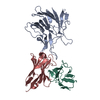
|
|---|---|
| 1 |
|
- Components
Components
| #1: Protein | Mass: 29297.074 Da / Num. of mol.: 1 Source method: isolated from a genetically manipulated source Source: (gene. exp.)  Gene: S, 2 / Production host:  Homo sapiens (human) / References: UniProt: P0DTC2 Homo sapiens (human) / References: UniProt: P0DTC2 |
|---|---|
| #2: Antibody | Mass: 13091.598 Da / Num. of mol.: 1 Source method: isolated from a genetically manipulated source Source: (gene. exp.)  Homo sapiens (human) / Production host: Homo sapiens (human) / Production host:  Homo sapiens (human) Homo sapiens (human) |
| #3: Antibody | Mass: 11381.535 Da / Num. of mol.: 1 Source method: isolated from a genetically manipulated source Source: (gene. exp.)  Homo sapiens (human) / Production host: Homo sapiens (human) / Production host:  Homo sapiens (human) Homo sapiens (human) |
| Has protein modification | Y |
-Experimental details
-Experiment
| Experiment | Method: ELECTRON MICROSCOPY |
|---|---|
| EM experiment | Aggregation state: PARTICLE / 3D reconstruction method: single particle reconstruction |
- Sample preparation
Sample preparation
| Component | Name: Complex of SARS-CoV-2 S-ECD with CM25 Fab / Type: COMPLEX / Entity ID: all / Source: RECOMBINANT | |||||||||||||||
|---|---|---|---|---|---|---|---|---|---|---|---|---|---|---|---|---|
| Source (natural) |
| |||||||||||||||
| Source (recombinant) | Organism:  Homo sapiens (human) Homo sapiens (human) | |||||||||||||||
| Buffer solution | pH: 8 | |||||||||||||||
| Buffer component |
| |||||||||||||||
| Specimen | Conc.: 0.3 mg/ml / Embedding applied: NO / Shadowing applied: NO / Staining applied: NO / Vitrification applied: YES Details: Sample was monodisperse. All S proteins had 3 Fabs bound. | |||||||||||||||
| Specimen support | Grid material: GOLD / Grid mesh size: 300 divisions/in. / Grid type: UltrAuFoil R1.2/1.3 | |||||||||||||||
| Vitrification | Instrument: FEI VITROBOT MARK IV / Cryogen name: ETHANE / Humidity: 100 % / Chamber temperature: 277 K / Details: -4 force, 3 s blot |
- Electron microscopy imaging
Electron microscopy imaging
| Experimental equipment |  Model: Titan Krios / Image courtesy: FEI Company |
|---|---|
| Microscopy | Model: TFS KRIOS |
| Electron gun | Electron source:  FIELD EMISSION GUN / Accelerating voltage: 300 kV / Illumination mode: FLOOD BEAM FIELD EMISSION GUN / Accelerating voltage: 300 kV / Illumination mode: FLOOD BEAM |
| Electron lens | Mode: BRIGHT FIELD |
| Image recording | Electron dose: 80 e/Å2 / Film or detector model: GATAN K3 (6k x 4k) |
- Processing
Processing
| CTF correction | Type: PHASE FLIPPING AND AMPLITUDE CORRECTION |
|---|---|
| Particle selection | Num. of particles selected: 330310 |
| 3D reconstruction | Resolution: 3.48 Å / Resolution method: FSC 0.143 CUT-OFF / Num. of particles: 215510 / Symmetry type: POINT |
 Movie
Movie Controller
Controller



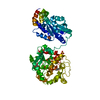
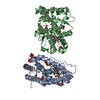
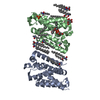
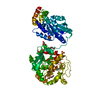
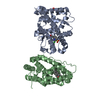
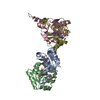

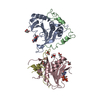
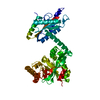
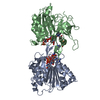
 PDBj
PDBj




